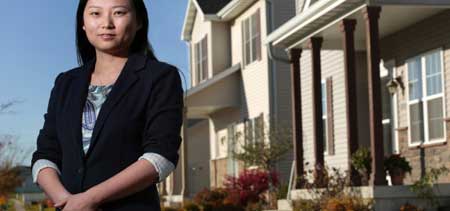Replacing an old incandescent lightbulb with new LED lighting might seem insignificant in reducing energy consumption. It is a simple step, but an effective one that shouldn’t be overlooked, said Yu Wang, an assistant professor of political science, who studies global energy policy and energy efficiency, at Iowa State University.
“Many people consider energy efficiency to be the low-hanging fruit,” Wang said. “If you’re facing the target of trying to mitigate climate change, energy efficiency should be the first choice because it’s cheap and easy in comparison with other options.”
Most importantly, energy efficiency programs and policies reduce overall energy use, without requiring consumers to conserve or cut back their current level of service, Wang said. According to her estimates, implementing a combination of energy efficiency measures, at home and at work, could yield potential electricity savings of 10.2 percent by 2035.
Wang and colleague Marilyn Brown, a professor at the Georgia Institute of Technology, analyzed federal, state and local energy policies for their book, “Green Savings: How Policies and Markets Drive Energy Efficiency.” Their research shows how effective policies lead to greater energy savings and greenhouse gas reductions.
“Most of the current programs and policies for energy efficiency can provide significant energy savings at a cost that is lower than the retail rate that we pay for electricity,” Wang said. “That means if you invest in energy efficiency, you will be able to get your money back and at the same time save energy.”
Why aren’t consumers embracing efficiency?
Based on Wang’s projections, it is unusual that more consumers are not implementing energy efficiency measures in their homes. Unfortunately, many will never realize these savings because of a lack of or misinformation about different options and other market barriers, Wang said. The misconception that homeowners must invest a lot upfront before they realize any cost savings is just one example.
But there are programs helping consumers navigate and understand the energy-efficiency market. The Home Energy Squad – sponsored by two Minnesota utility companies – is an effective information-based program, Wang and Brown highlighted along with other outstanding efficiency programs in their book. Wang says the Home Energy Squad conducts a comprehensive energy audit and provides homeowners with a detailed list of energy-efficient upgrades and recommendations. Homeowners know upfront what it will cost and how much they can save.
“Energy efficiency programs don’t only look at your old appliances such as an old refrigerator or microwave. They also look at the cooling and heating equipment or old windows that need to be replaced,” Wang said. “Sometimes they will also help you to install all the possible measures and offer financial supports.”
Several utility companies offer similar programs, but there is little incentive to do so because of the for-profit business model, she said. Reducing energy consumption reduces profits for utility companies which charge consumers based on electricity usage. Wang says state and local governments need to remove this disincentive by decoupling utility revenue from sales.
Effective, enforceable policy needed
It will take a global effort to mitigate the effects of climate change. Wang says the federal government needs to lead the way by setting a national target for energy efficiency, and the U.S. has a lot of room for improvement when compared to other countries. The American Council for an Energy-Efficient Economy ranked the U.S. 13th (out of 16) on its 2014 International Energy Efficiency Scorecard. Germany topped the list. The U.S. came in behind China, India and South Korea.
This international comparison is important, because climate change is not specific to one country or region, Wang said. The lack of a national energy efficiency policy or target is one area in which the U.S. failed when compared to other countries. She says multiscale complementary government policies will maximize savings.
“That could mean having a unified, consistent national target and giving states the flexibility to choose specific programs they want to run or specific technologies they want to subsidize or support,” Wang said.
She added that it will take a combination of financial incentives, regulations and information-based policies to make a visible difference. There are several leaders – including Massachusetts and California – which local and state governments can learn from and adopt similar policies. Enforcement is also critical. Wang says some states have stringent building codes, but do not follow through on compliance.
Wang stresses that all avenues, including conservation efforts and renewable energy sources, are necessary to address climate change. However, the energy efficiency market is a more affordable option than many renewable sources and does not require consumers to change their habits and routines.
“We should not just forget about the demand-side resources, and energy efficiency is one of them that can save us a significant amount of energy and at the same time save us money,” Wang said. “Energy efficiency is such an important, low-cost solution to climate change.”
Reference(s):
Story: Addressing climate change should start with policies to increase energy efficiency | Iowa State University — December 02, 2015













Comments